How does it feel to go back to a city you left three decades ago? Will you remember anything? Will you recognize some places?
To begin this story let me take you back in time, 32 years ago to be precise. Due to his work in the past, my father had to live in Banjarmasin, the capital of Indonesia’s South Kalimantan province on the island of Borneo, away from my mother and I in Semarang on Java. When I was one and a half years old, my mother decided to move across the Java Sea to join her husband and build a new life together, sacrificing her well-paid job as a traditional Javanese dance teacher. Everyone knows that starting a new life is not only challenging (my mother came from a household with two maids, so she practically never had to do any housework), but also daunting, especially for a first-timer. But she did it anyway.
For 1.5 years the three of us lived in a stilt house, provided by my father’s office, in a city known for its many rivers and swamps. I cannot recall much of that time, but my mother told me it was not unusual to have snakes coming into the house. In 1988 we all moved to another, and much smaller, city in the same province. To my younger self, Pelaihari, as the city is called, was merely a place with no street lights (the only lights at night came from cars and motorbikes which were very rare at that time) and a vast tract of barren land not too far from our house (it might have been a coal mining site or land cleared for palm oil plantations). Then a few years later we moved again to a slightly bigger city called Tanjung, still in South Kalimantan, where an ‘eternal fire monument’ stood in the middle of a roundabout.
Since my parents and I moved back to Java in 1991, none of us has ever returned to the Indonesian side of Borneo, until this year when a long weekend at the end of March gave me a spur-of-the-moment idea to go back to Banjarmasin. It is, after all, the city I was named after: BAnjarMAsin.
James and I departed from Jakarta with no expectations; it had been so long since I left the provincial capital of South Kalimantan, and I didn’t expect to recognize anything except the city’s main mosque where my father took a photo of me in front of it (sadly the photo was washed away when a flood caught my parents by surprise upon their return from a trip about ten years ago). On the news, I have been constantly reminded about how conservative the city is, and just a few days before our trip, attempted daylight robbery happened on the street where our hotel was located. Luckily bystanders reacted quickly and saved the victims from a potential loss of their belongings.
After more than an hour in the air, the coastline of southern Borneo slowly came into sight; a muddy estuary a telltale sign of the erosion upstream. A few minutes later what seemed to be office buildings emerged, sitting in a well-planned development suggestive of a relatively recent construction. One building, in particular, caught my attention the most, with a tall triangular roof which then sloped all the way down over its elevated veranda. Suddenly a flood of memories filled my mind. I remembered seeing that kind of structure when I was little, probably in Banjarmasin, Pelaihari or Tanjung, I can’t remember exactly. Moments later I felt this warm feeling, as if I was meeting an old friend I had never communicated with for far too long. Later I learned from Iwan, our driver during our stay in the city, that what I saw was actually Banjarbaru, a city created in 1999 which now hosts some of the province’s most important buildings including the governor’s office.
Despite the small and outdated airport terminal building, our arrival was a rather pleasant affair. A couple donning the costume of the Banjar people greeted us at the entrance to the baggage claim area, while a Dayak (indigenous ethnic groups of Borneo) ensemble played their traditional music inside the building. On the way to the city, Iwan, our very friendly driver who was in fact from Java chatted with us and talked about his decision to move to Banjarmasin following the eruption of Mount Merapi near his native Yogyakarta back in 2010. Like my mother three decades ago, Iwan started his life anew in his adopted city with his family. Looking out of the car window, the road was lined with shops, office buildings and houses. “When I was a kid, none of this existed, only forests,” I recalled.
After checking in at the hotel, situated on the banks of the Martapura River, we went to Sultan Suriansyah Mosque, commissioned by the first Muslim ruler of the Banjar people more than four centuries ago. Located a bit further north from the city center, we followed small streets that meandered along the tributaries of the Martapura River, occasionally catching a glimpse of the locals’ river-bound life. Unlike most modern mosques which are capped with domes, this old mosque’s roof shape reflects the vernacular architecture that was prevalent at that time. Today, however, only parts of the mosque are still original, including the four main pillars of the prayer hall.
A few days before leaving for Banjarmasin, I asked my mother about the local food we should try in the city, and unsurprisingly she gave me a long list of those dishes, with a specific time when to have them. Itik panggang (roast duck) was our pick for lunch, and after exploring the centuries-old mosque, off we went to Depot Madezo, recommended by our local friend, Sherly. She warned us that the place might not be too comfortable, but this street-side eatery was more spacious than I thought, although it was a little too dark to take photos of the food. The duck came in bite-size pieces with sweet sambal (chili sauce). It also came with a clear soup and rice noodles, and a plate of rice (we love our carbs here in Indonesia!). Everything turned out very delicious, a satisfying start to our culinary adventure during our short stay in the city.
As soon as we finished our meal, James, a foodie at heart, proposed a rather crazy idea.
“Do you want to go to another place to try more dishes?”
“Now?” I was more amused than shocked.
About half an hour later we found ourselves sitting cross-legged inside a big stilt house which had been converted into a popular 24-hour restaurant. “This is where the locals hang out,” Iwan told me on our way there. We ordered a Banjar specialty I had been curious to try: ketupat Kandangan with haruan (snakehead murrel). While waiting for the dish to come, I realized that we were sitting on something I still vividly remember from my childhood: lampit, a local mattress made from rattan. We used to have it in our house during my father’s tenure in South Kalimantan, and one thing I recall is its plaited edges. Sitting on one after all those years truly evoked a certain nostalgia.
Then before long the dish came; sliced ketupat (rice steamed in a packet of woven palm leaf) with fried haruan served in a sauce made from coconut milk, turmeric, lemongrass, candlenut and other spices. Originally from Kandangan, a namesake district in the province, traditionally the dish is eaten by hand with the ketupat mashed into the creamy sauce before scooping it into your mouth. “I don’t see the point of them making ketupat when they eventually eat it like normal rice,” my mother jokingly said to me once. As I tasted the sauce, rich yet balanced flavors exploded onto my palate. I looked at James, who nodded as his eyes widened. Later he told me that it is now one of his favorite Indonesian dishes.
Full and satisfied, we retreated to our hotel and called it a day, for the following day would be a long one.
We woke up at 3am, far too early even for an early riser like me. But on that day we were about to go out of the city, not to climb a mountain, but to see what Banjarmasin is well-known for among Indonesians: its floating markets. We opted for Lok Baintan – one of two such markets that still exist in and around Banjarmasin – which according to Iwan could be reached by car in about one hour, if not a little more. However, we decided to rent a boat for a more unique experience. An article I read prior to our trip says that going to Lok Baintan by boat from the city will only take about half an hour, so I expected to arrive at our destination just before 6am, the supposedly peak time of the floating market’s hustle and bustle. We went to a pier near Sultan Suriansyah Mosque as it was there where Iwan took a boat several years ago to visit Lok Baintan. But no one was at the pier when we arrived, and there was not even the slightest sign of human activity. Thankfully half an hour later, with the help of our driver, we managed to find a boat captain who happened to be walking nearby. Negotiating the price was easy, so was getting on the boat in darkness. But instead of going to the east – where Lok Baintan is – the boat headed to the west.
Still feeling sleep deprived, I didn’t realize this until the boat left the small river and came into a wide body of water which in darkness almost seemed like a big lake. James and I instantly felt something was not quite right, since the Martapura River that we were supposed to cruise shouldn’t be this wide. This must be the Barito, one of Borneo’s mighty rivers that cuts through the island’s dense jungle – or what is left of it. At certain places both of the river’s banks are separated by about a kilometer, making it the widest river in Indonesia.
“We’re going to Lok Baintan, aren’t we?” I asked a crew member this to seek an answer to my confusion.
His reply was a short yes.
Moments later we figured out why the boat had to make a detour: to stop by a shop and buy a jerry can filled with petrol for the rest of the journey. Relieved, I made sure the boat eventually turned east and hoped that we could reach the famous floating market before sunrise.
The captain surely and steadily piloted the boat through the calm waters of another small river that would merge with the Martapura River. We passed by stilt houses, hundreds or even thousands of them, with their dwellers slowly waking up to the sound of the Islamic call to prayer. Occasionally I saw the silhouette of big ships, seemingly too big to be on this side of Banjarmasin’s riverine landscape. But there they were, anchored near warehouses or at slightly wider sections with nothing but dark marshes in the background. I was wondering whether or not I would see the reflections of crocodiles’ eyes on the river’s surface.
One and a half hours into the journey we were still far from Lok Baintan, but the sky was still dark so I just took it easy while trying to keep myself awake. However, a few minutes later, one, two, three tourist boats overtook ours, then four, five, six… I lost count. I didn’t realize how slow we were until the moment we were left behind by those faster and slightly bigger boats whose engines were not heard fifteen minutes earlier. Ten, twenty boats passed us by and I could only hope that when we finally got to the market those local women selling fruits, vegetables and other things would still be there.
The cloudy sky began to look brighter every minute on our journey eastward, and we were already past the supposedly peak hour of the market at six. Finally at seven we arrived at a part of the river where there seemed to be a lot more tourist boats, dwarfing local vessels which were each manned by a woman expertly paddling through the busy waters. Several of them were selling fruits – some looked unfamiliar to me – and snacks as well as traditional cakes, and like butterflies hopping from one flower to another, they went from one tourist boat to another, wishing to stumble upon that one tourist who would buy their produce in large quantities. Of course, we only bought a few items here and there, but that morning we were introduced to some fruits we had never tried before, including buah mentega (literally ‘butter fruit’), also known as velvet apple which is in fact native to the Philippines.
Still unsure whether the ‘market’ we were at was created for tourists or a real traditional market, I spotted some women who didn’t bother to come close to any of the tourist boats. Instead they were doing transactions with other women, buying and exchanging items from raw chicken to duck eggs since transactions are done both in cash and through bartering at this ‘floating’ community. Maybe if we had arrived one hour earlier we would have seen more of such vendors.
With several sugar-dusted donuts, two velvet apples, and two local citrus fruits in our hands, we were ready to go back to the city… at least not until the crew managed to fix our boat’s engine. This very boat took us to the market much longer than we had anticipated, and now we had to wait until it got fixed. Life really is like a box of chocolates, isn’t it? You never know what you’re gonna get, even down to getting a proper, working boat.
Lunch was a much easier affair. We met up with Sherly in the city for a feast of grilled silver catfish, fried glass catfish, coconut milk-based soup, and mango sambal at Depot Sari Patin. The soup was sweet and flavorful, and the fried glass catfish well-seasoned. But the real star was the grilled fish; not only was it grilled to perfection, but it was also very meaty and juicy with plenty of fat, making it one of the most succulent kinds of grilled fish I’ve probably ever tasted. Hats off to Sherly who recommended all those places to eat so we could try the best local dishes during our short stay in Banjarmasin.
In the morning of our last day in the city, Iwan took us to Sabilal Muhtadin Mosque, the biggest mosque in the city as well as the only place in Banjarmasin I still remember from my childhood. Standing on the site of a long-lost Dutch fort, the mosque which was built in 1981 bears different architectural styles: its space-age dome (as James called it) reflects the modernism prevalent at that time in Indonesia; its minarets appear to be a magnified version of a fencing épée; while its doors and windows were inspired by the traditional motifs of the indigenous Dayak people. I asked James to take a few shots of me at the exact same location where I had my photo taken three decades ago, and I couldn’t help but feel nostalgic afterward – one of many such moments during this particular trip.
After the mosque there was one last place we wanted to visit before going to the airport to catch our flight back to Jakarta: a museum which, as Iwan told us two days ago, is among the last surviving traditional Banjar houses in the city. Known as Bubungan Tinggi, this type of house once served as the core building of a palace, although the one we were heading to was never a part of any royal compound. Museum Wasaka, as it is called, sits on the bank of the Martapura River. Its decorative wood carvings adorn the edges of the tall roofs, while the weight of the entire structure is distributed among the many stilts that support it. Unfortunately the museum was closed, although that was due to renovation work carried out to preserve this precious cultural asset of Banjarmasin.
Not quite ready to leave the city, we had one more dish we had been very eager to try, none other than soto Banjar. Possibly the most well-known Banjar dish beyond the borders of South Kalimantan, this clear soup made from an array of spices which is served with vermicelli, shredded chicken, fried potato patties and hard-boiled egg is light but rich in flavor. It is the only Banjar dish my mother still makes at home, and it was the first meal I had after recovering from a case of dengue fever fifteen years ago. At Soto Banjar Bang Amat, we had the namesake dish but also a side of chicken sate/satay (skewered meats easily found in Indonesia, Singapore and Malaysia) which, unlike in other places where peanut sauce or sweet soy sauce is used, was smothered in masak habang – a typical Banjar sauce made from dried red pepper, palm sugar and other ingredients.
Long gone are the days when I spoke the Banjar language fluently. But this trip has reignited an affection for a city with which I have a special connection. Banjarmasin showed me different sides of the city and its people that are not usually portrayed in the media. But I shouldn’t have been surprised since that is also the case with many other places around the globe, places that beckon us to go there and experience their lesser-known charms for ourselves.



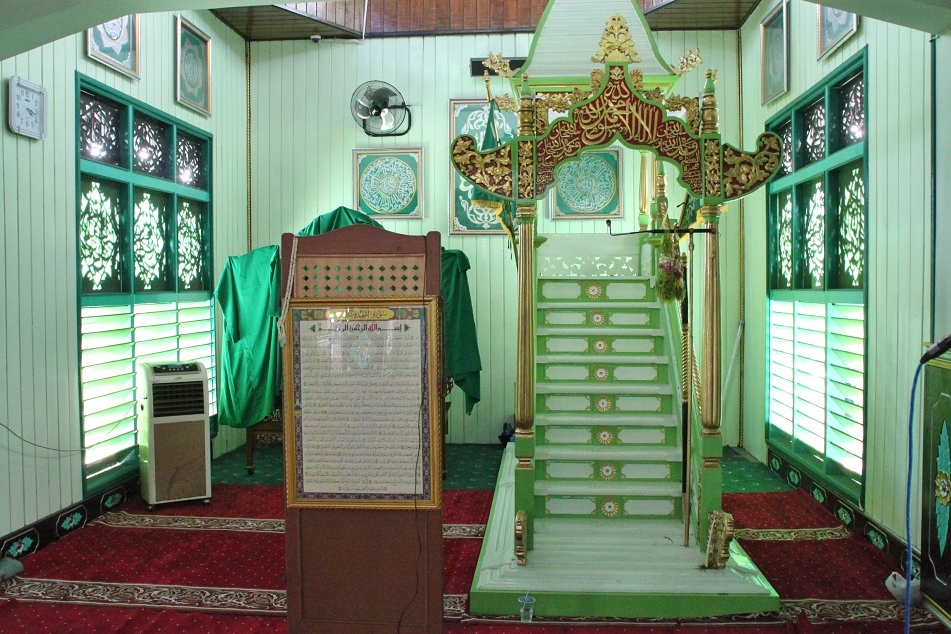
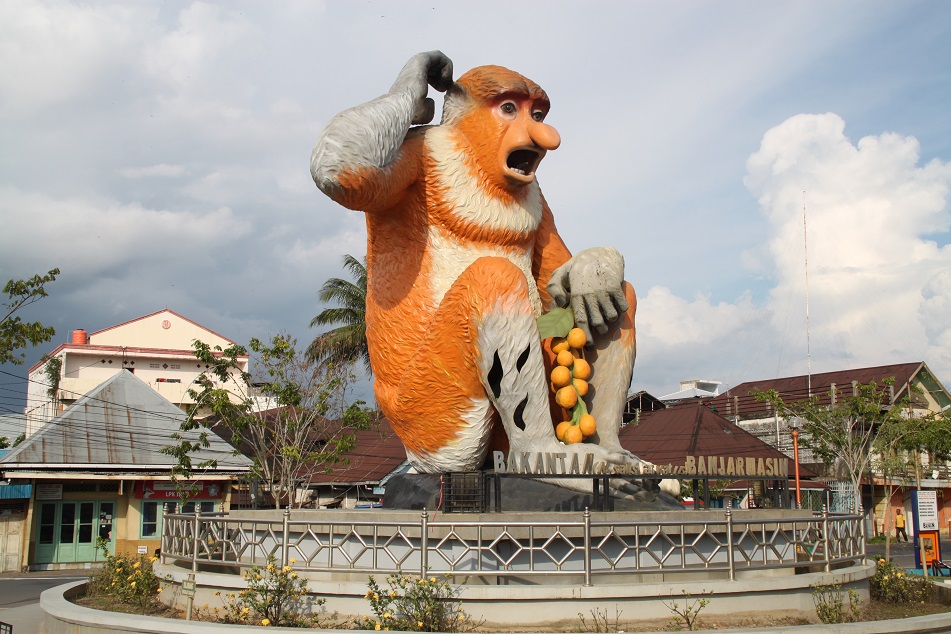




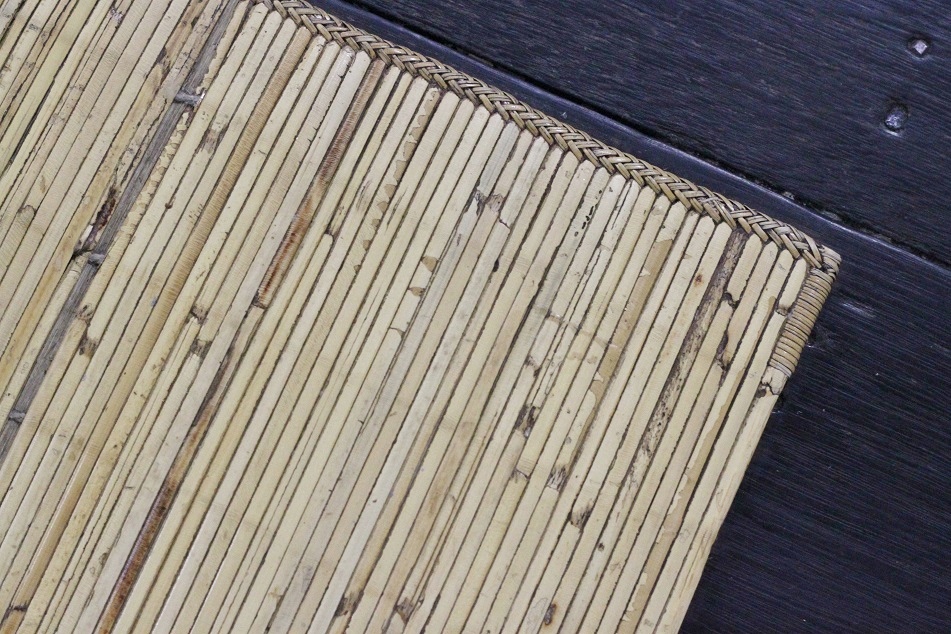




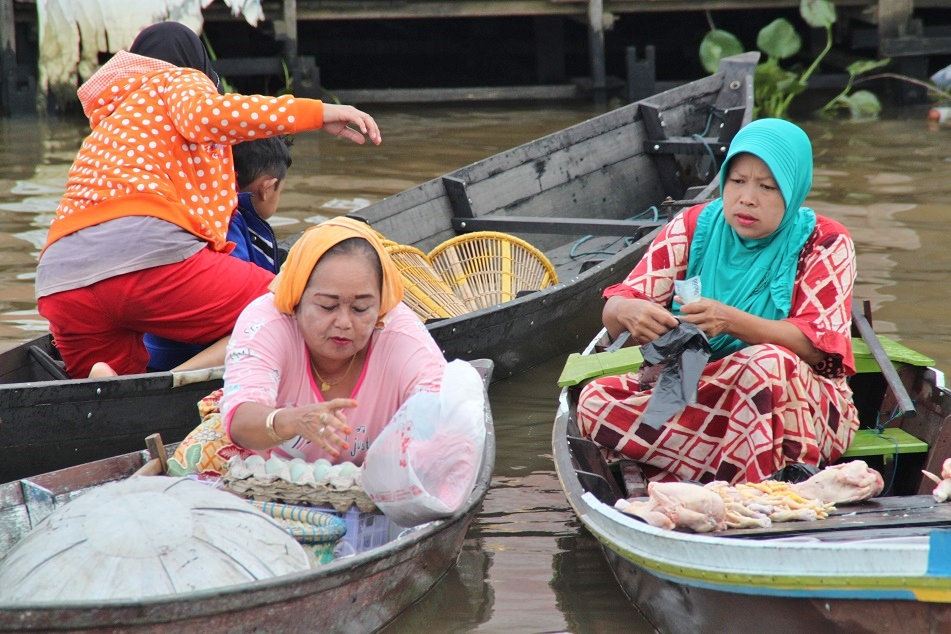

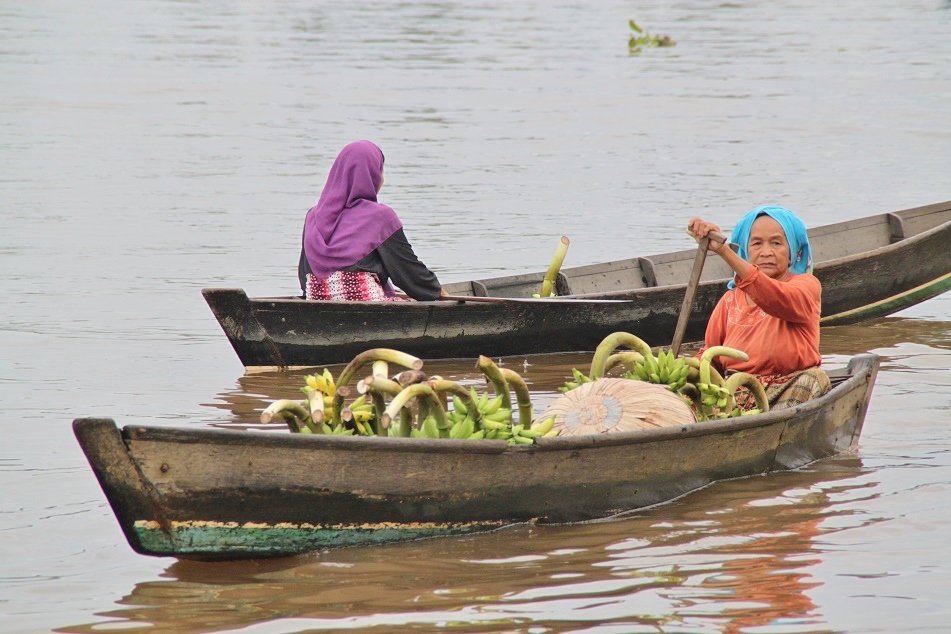

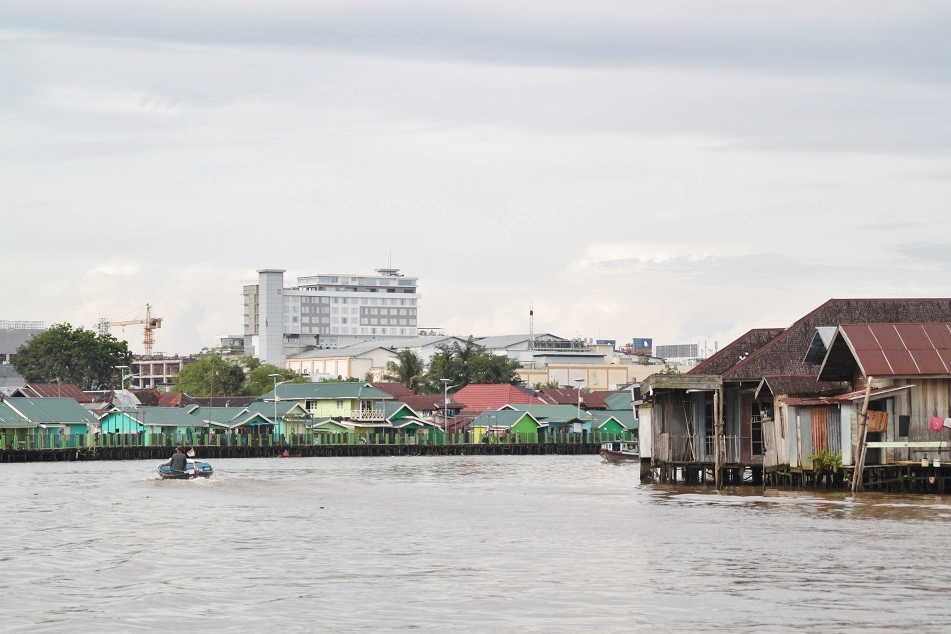
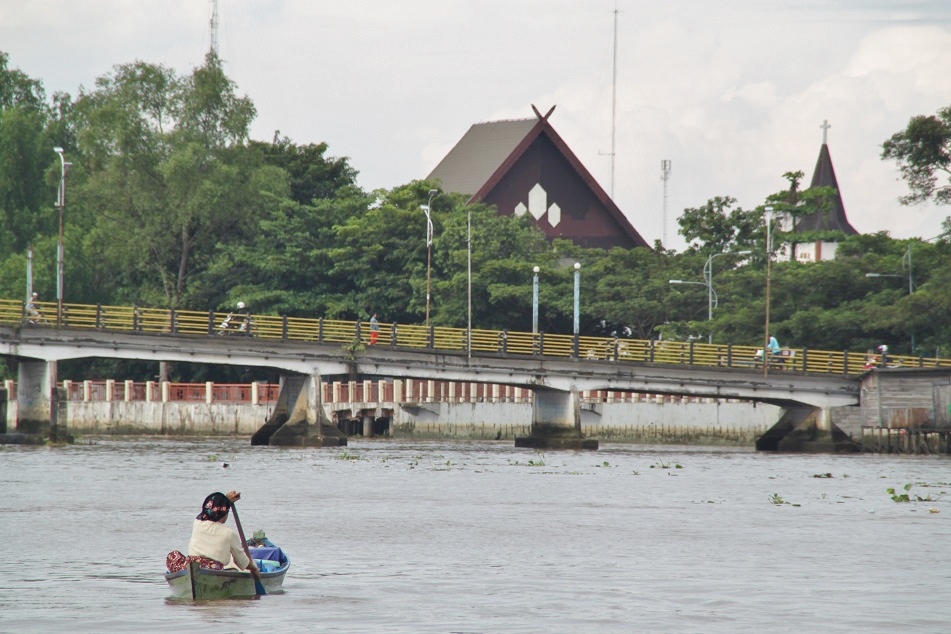

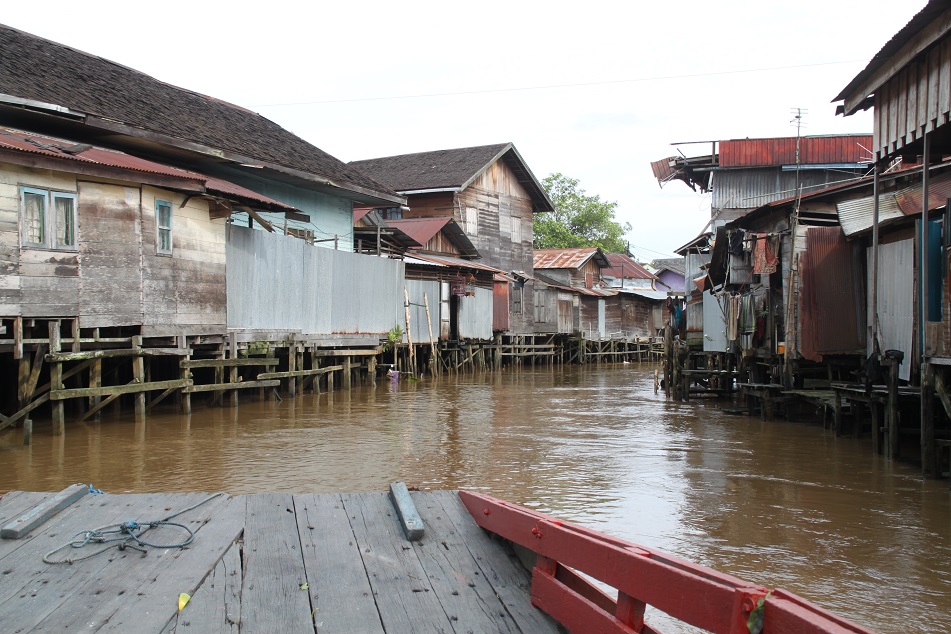
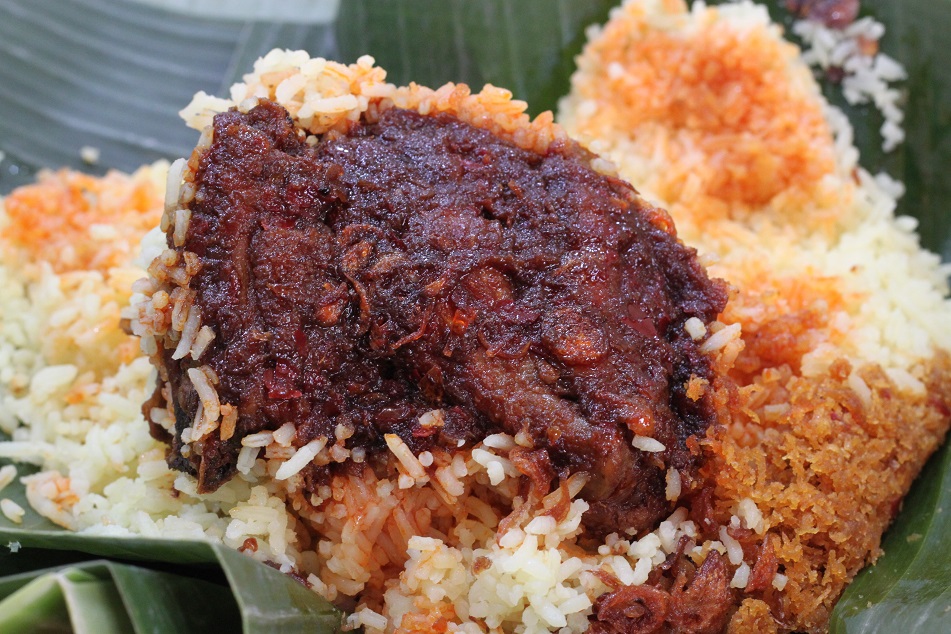








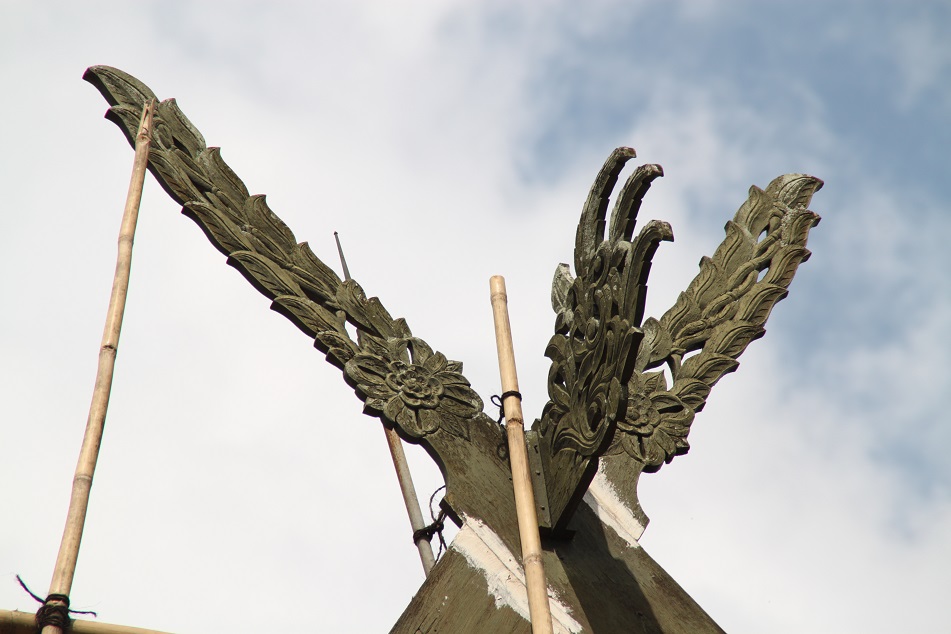

I lived in Borneo when I was a kid. The traditional houses have unique high roof.
LikeLike
Which part of Borneo did you live in? Was it also Banjarmasin/South Kalimantan?
LikeLike
No. I lived in the city closer to equator, Pontianak, West Kalimantan. ☺
LikeLike
That’s actually where I’m thinking of going next time I get the chance to go to Borneo!
LikeLiked by 1 person
Mas Bamaaaa…
Duh I love this post so much, nostalgianya berasa benerrrr antara mengingat-ingat dan lupa beneran. Itu juga saya alami waktu trip ke Balikpapan setelah sekian puluh tahun. Tapi waktu itu sih saya blaaasss lupa hanya samar-samar ingat dari rumah di ketinggian bukit yang melihat pantai. Tapi mas Bama masih enak, bisa mengingat tempat-tempat di masa kecil. Seru banget trip kali ini ya.
Apalagi waktu perahu itu ke Barito waaah gak bs dibayangin deh. Dulu waktu aku liat pake mobil aja rasanya lebaaaaaar banget apalagi diatas airnya ya… sereeeemmm…
By the way, met puasa ya mas… lhaaa ini dipost foto makanan yang ngebayanginnya aja bisa batalin puasa hahahahaha…. kecehhh…
LikeLike
Makasih Mbak Riyanti. Itu beneran lho pas saya lihat rumah Bubungan Tinggi dari pesawat, dada saya langsung berdesir dan mata saya agak mbrambang. Tiba-tiba aja gitu jadi inget beberapa hal dari masa kecil hanya gara-gara lihat bentuk bangunan itu. Trip ke Banjarmasin ini dari yang semula cuma iseng mumpung ada long weekend malah jadi perjalanan yang berkesan banget.
Met puasa juga ya mbak. Foto makanan hanya sebagai ilustrasi dan semoga bisa memberi ide nanti sore mau buka puasa di mana. 😀
LikeLike
A great journey. Love the Proboscis Monkey statue!
LikeLike
It really was an unforgettable journey. Thanks for reading!
LikeLike
Reblogged this on The I-Ronnicles.
LikeLike
Another wonderful travelogue from you, Bama. Interesting to read about the town where you were born and lived in your early days, Banjarmasin, and interesting to hear that your name takes after the town. I can relate when you say that a place never as we remember it. I am sure those forests are still fresh in your mind, and you can still picture them even thought new buildings are right in front of you. That is the power of memories and how we can feel about a certain place where we’ve created ‘history’, where we’ve been so to speak, like in your case how you can remember the lampit.
Always must try to the local food when you visit a place. James is the smart one – eat as much as you can 🙂 Never knew ketupat came with creamy coconut sauce. I had ketupat with other dishes but never with just sauce. Maybe it’s different from ordinary rice in that the ketupat rice soaks up the woven palm leaf flavours and scents 🙂
It sounded like a scenic boat ride, alongside the markets. Tourist attraction or not, ultimately the sellers are trying to make a living and I’m guessing they were happy to see you if they weren’t busy trading 🙂 Lesser known charms…really like that phrase you used and it Banjarmasin does sound like one of those places. Wonderful photography as usual alongside your heartfelt words.
LikeLike
Much appreciated, Mabel. Going back to a place we visited in the past may be a good or bad decision, but for sure revisiting Banjarmasin after more than 30 years proved to be a decision I never regret. However, there’s one place in eastern Indonesia where I don’t see myself returning; it was such a peaceful and pristine place, so much so I’m afraid that if I return one day I will be disappointed to see some possible changes.
James is definitely a person to listen to when it comes to food as he always comes up with great ideas on what, where and when to eat. As for ketupat, in Indonesia we have it mostly with coconut milk-based dishes. One that my mom always makes every year is ketupat with opor — rich turmeric soup with chicken, coconut milk and a lot of spices.
Even though we arrived quite late at the floating market, that was still a nice experience. I can imagine how much more vibrant and colorful it must have been an hour earlier! Thanks for reading and sharing your thoughts, Mabel!
LikeLiked by 1 person
The taste and smell of food also brings back my memories. You must have been thrilled with all the changes that happened on Borneo while you were away for such a long time. Bama.
LikeLike
It’s very fascinating indeed when you still recognize a few things from a place you had left a long time ago, and that certainly was how I felt on my recent trip to Banjarmasin. That makes me think whether at one point I should also pay a visit to a small city where I went to primary school for I have clearer memories of how it looked like. Thanks for reading, Peter!
LikeLiked by 1 person
What a nice retracing. Hopefully you visited Pelaihari, Tanjung and Banjarbaru as well. I’m waiting your next articles 🙂
LikeLike
Unfortunately since I went to Banjarmasin on a long weekend I didn’t really have enough time to go to Pelaihari and Tanjung as well. Maybe next time!
LikeLiked by 1 person
Well, you have drunk water from the river in Pelaihari and Tanjung, so I’m quite sure that you will be back there 🙂
LikeLike
Hopefully one day! 🙂 I’m curious with how much those cities have changed.
LikeLike
Love the 16th century style mosque — so unique to Indonesia. Great that you enjoyed returning to Banjarmasin after decades; sometimes such trips can be full of disappointment. Must say though, when I return to where I grew up, I find the city looking better and better. I’m about to do that next week.
LikeLike
Mallee, when I was choosing the photos from the mosque, I remembered what you said about such mosque roof in one of your earlier comments. It would indeed be very nice to see new mosques built in such traditional style as opposed to domes and minarets which have now seemed to become the norm. Looking forward to reading your story on the city where you grew up!
LikeLiked by 1 person
A stunning style — a pity lose the beauty and uniqueness of these mosques.
That’s Brisbane where I’ve been making odd posts since my last visit a year back (and another one today).
LikeLiked by 1 person
Was your mother an outlier at the time she chose to leave her good job and comfortable life to join your father? She sounds like a strong woman! Going back to a childhood home is often fraught with nostalgia and other strange feelings; for me, it seems both warmly familiar and somewhat alien. It certainly always seems smaller than I remembered and not as nice!
Is it common to take one’s name from a city name in your country? Fun to read a bit more of your family history, and I’ll bet it was gratifying to share it with your friend James, too!
LikeLike
I don’t know whether or not she was an outlier, but for sure she has always been a fighter — a rebel in her own words. Speaking of childhood home, there was one occasion six or seven years ago when I attended a friend’s wedding in a city where I spent my high school years, and before going back to Jakarta I made sure to drive pass the street where the house we used to live in was located. And you’re right, it looked smaller than I remembered.
In some parts of Indonesia, the rules for naming a person are pretty much similar with how people do it in the West (i.e. you take your father’s surname, and so on and so forth). However, in the rest of the country, naming a baby really depends on his/her parents’ creativity. That’s why whenever we travel to a Western country where we need to arrange a visa in advance, we always have to provide documents stating the relationship between one family member and another (i.e. birth certificate and ‘family card’ which lists all the names of one’s parents and siblings).
Both James and I really enjoyed Banjarmasin. It’s not the prettiest city of all, but it certainly has its own charms.
LikeLiked by 1 person
What a beautiful experience to go back to your earliest roots after such a long time. It looks like you and James sure packed in a lot. I don’t know how you managed it all, including eating all those incredible dishes and your longer than anticipated boat ride.
This is a part of Borneo I have not previously read anything about. Is it on the foreign backpacker’s radar?
The monkey statue made me smile. I love a town with a characterful roundabout.
LikeLike
We certainly packed in a lot. Getting up early and mentally preparing ourselves to get stuffed helped a lot for us to enjoy what Banjarmasin had to offer, and thanks to our local friend Sherly we managed to try some of the best dishes in the city. I don’t think Banjarmasin, or South Kalimantan in general, is on the foreign backpacker’s radar; in fact it’s not even in the radar of Indonesian backpackers either. There were some visitors from Java as well as foreign tourists during our stay, but they were mostly families.
Caroline, actually when I was taking some shots of that statue, I thought of that durian roundabout photo you took in Kampot!
LikeLiked by 1 person
Haha…the monkey statue ranks right up there with the durian one. I may have a new mission in life finding the most fun statues around the world (SE Asia definitely has more interesting/playful ones than ones I’ve seen here). Borneo is on my list of places to visit. Now in addition to the more well-trodden routes I’d like to add South Kalimantan. Thanks again for introducing me.
LikeLike
I remember some of the places on Java that I visited during my childhood had really cool roundabout statues — a three-headed rhino and a giant dry-cell battery to name some. You just gave me an idea of what to look for my future trips in this part of the world. 🙂 Hope you’ll make it to Borneo one day!
LikeLike
It’s intriguing to see how life can be different at different latitudes! What’s utterly exotic for me must be normal for you, and viceversa. That waterbourne market, moving about to intercept customers, is a hell of an idea, and the “My boat is rainproof” made me chuckle.
From a pure architectonical POV, normally buildings (not just mosques) like Sabilal Muhtadin Mosque are in nude concrete, which to me is ugly as hell; it was refreshing to see one covered in stone and so well kept! Thanks for the trip to Borneo, Bama.
LikeLike
What you said reminds me of what my mom thinks of exotic food which includes pasta, pizza and nachos. Cowskin crackers, duck eggs and shrimp paste which to her are normal things to eat are perceived as exotic by people from the other side of the world. That’s why traveling beyond places we’re familiar with often rewards us with some of the most memorable experiences in our lives. It would have been nice to see the hustle and bustle of the floating market during its peak time, but anyway, it still was quite interesting to see how those women paddled back and forth to sell those fresh fruits and snacks to curious visitors. I can attest that Sabilal Muhtadin Mosque looks a lot prettier than the biggest mosque in Jakarta, which a friend once described as a ‘Soviet building topped with a dome’. Thanks for reading, Fabrizio!
LikeLiked by 1 person
Cowskin crackers?!? Want some!!!!
LikeLike
Ah, so your name is derived from “Banjarmasin”. Your parents had an interesting idea 🙂
the water labyrinth reminds me of my visit to Palembang and Pontianak. I always love a city with a clean river, it’s like blending people with nature. Banjarmasin is already on my bucket list 😀
LikeLike
When I was in Palembang I also rented a boat to take us to Pulau Kemaro, although it was a lot smaller than what we took in Banjarmasin. As for Pontianak, I’m really interested in seeing how the city’s multicultural population contribute to shaping its identity. I’ll definitely check your blog post on Pontianak once I make a plan to go there.
Speaking of my parents, you have no idea how ‘creative’ they are with names! 🙂
LikeLike
You’re right, that fact leads me to another question: what does “Harinda” mean?
LikeLike
I’ll tell you when we cross our paths one day! 🙂
LikeLike
Haha, okay. Can’t wait!
LikeLiked by 1 person
Wah, namanya ternyata dari Kata Banjarmasin. Cool. Kalo bicara tentang Banarmasin gak bisa lupa soto, acil, wadai, dan sungai. 😀 😀
What a nice recall of Banjarmasin, where I used to work. 🙂
LikeLike
Waktu saya lagi nunggu jemputan di Bandara Syamsudin Noor, saya buru-buru telepon ibu saya mau tanya beberapa kosakata Banjar. Salah satu yang diajari ibu saya ya kata acil itu. 🙂 Wadai saya malah gak nyobain sama sekali nih. Hmm.. perlu balik lagi ke sana sepertinya.
Wah, jadi penasaran dulu waktu masih kerja di sana Banjarmasin seperti apa ya, apa mirip dengan sekarang atau malah saat ini kotanya udah jauh berubah.
LikeLiked by 1 person
Terakhir Bulan Desember 2016 sih, secara garis besar baru, tapi pertama datang di KalSel, tahun 2012 akhir, Patung Bekantan belum ada, sama Pasar Terapung dekatnya. Pasar Terapung hanya di Lok Baintan sama satu lupa Lok apa namanya, bisanya dapat kalo subuh banget. Jam 6 pagi udah mau bubar Pasar itu. 😀
Wadai Acil bulan Ramadhan gini keluar semua, di pasarnya Ramadhan. Coba deh. Selalu duluan ke pasar, ngalah2in yang puasa. Kekekekeke.
LikeLike
Tuh kan, jam 6 pagi malah udah mau bubar pasarnya. Berarti saya memang sampe di sana telat banget, gara-gara kapal yang jalannya kayak siput. Padahal udah dari jam 4an siap-siap di dermaga di dekat Masjid Sultan Suriansyah.
LikeLike
Wonderful in every way. Thank you.
LikeLike
Glad you enjoyed this post. Thanks for reading!
LikeLike
Akhirnya ‘pulang kampung’ juga kau bamskiii… grilled fish nya itu sungguh menggoda lah 👌🏻👌🏻
LikeLike
Kampungku banyak Inang.. 😀 Itu ikan patin bakarnya beneran enak pake banget! Kamu pasti gak cukup kalo cuma satu, hehe..
LikeLiked by 1 person
Wah keren, bagus2 tulisan nya..full of information,,:)
LikeLike
Terima kasih, Jidda. 🙂
LikeLike
Bama, I really enjoy reading your blogs from Indonesia especially. When I was in Malaysia last year, our scuba diving instructor came from Borneo. I’ve always wanted to go there due to the orangutans. How nice that the trip evoked such nostalgia in you. The dishes look so delicious! Roast duck especially, yum! I have neither met Indonesians nor lived in countries with Indonesian communities, so I am very unfamiliar with the cuisine. When I visited your neighbors, the Philippines, few years ago, I wasn’t really impressed by the cuisine there.. but it definitely sounds like a different story in Indonesia.
I didn’t realize that the area you visited had enough tourists for the vendors to stage (kind of) a floating market just for them. At least you spotted few women who didn’t really bother with the tourists and were actually there for local business. The touristy versions of anything is really just a watered down version of the real thing for many times the price hehe. I like traveling in Asia because I blend in quite well as a Nepalese and don’t get treated like a rich tourist from the West. With the Polish boyfriend however, it’s a different story hehe.
LikeLike
Indonesians are often mistaken as Malaysians or Filipinos when we travel abroad. I remember when my ex-coworkers and I went to Istanbul in 2013 some vendors at the Grand Bazaar thought we were Malaysians. About the food, I only have a very limited experience with Filipino cuisine. Until recently all I heard was that Filipino dishes were not as refined as those from Indonesia. However, my best friend recently went to Cebu (the second biggest city in the Philippines) and he raved about the food he tried there.
When managed properly, tourism is generally good for local economy. However, problems will arise as soon as it gets out of control (i.e. when money is all that matters). Banjarmasin isn’t really a main tourist destination in Indonesia, hence my confidence that it will retain its charm for a foreseeable future. I can imagine the attention your boyfriend attracts when he travels in Indonesia! Most people would want to take pictures with him. 🙂
LikeLike
That was one short but eye-opening trip, Bama! It was an absolute pleasure to tag along on this journey down memory lane – and I absolutely do not regret the back-to-back meals we had the first night. Given my soft spot for turmeric and coconut milk, I’m not surprised that ketupat Kandangan was my favorite Banjar dish. 😉
Someday we’ll have to go back to eat more of those local specialties. And then we should probably ask Pak Iwan to drive to us to Lok Baintan so we can visit the actual floating market. That’s plenty of reason to return, I think!
LikeLike
I was actually not surprised at all that you ended up really enjoying ketupat Kandangan. Next time we find an Indonesian dish that looks rich and yellow, there’s a great chance that you’ll like it. 🙂 If you think of it, the only Sundanese dish that you like has turmeric in it.
I will definitely ask him to drive us to Lok Baintan. Apparently even before six the floating market is supposedly packed with vendors’ boats! When we do return, I think I’ll go back to Depot Sari Patin to have more grilled patin.
LikeLiked by 1 person
Interesting that you’ve forgotten the fluency in the language. It simply goes to show that if you don’t use something that that skill simply becomes rusty, rather than entirely forgotten. The meal that helped cure you from the dengue fever – how did it work in such a way? Also, I see that the water is brown, kind of like how I saw it to look at the Mississippi and at Varanasi. I know that the water is brown in Varanasi due to the immense pollution. I know that the Mississippi is brown because of sediments with pollution and the Rio Grande in New Mexico is just brown anyway due to sediments and the fact that it is not entirely full. Why is the water brown in this story’s case? Also, how old is Banjar and the culture there? One of my bucket list items is to experience the boat markets of Indonesia.
LikeLike
I’m also losing my French now, which is quite a shame because when I went to Paris and Brussels back in 2007 it came handy for navigating my way in both cities and for talking to the locals. The meal didn’t actually cure me; it was the first proper meal I had after days only eating bland hospital food. About the color of the river, my guess is it’s mostly due to the erosion upstream, although pollution certainly exacerbates the problem. And as for the Banjar culture, I have to find out more about it. But what I know is that the Malay people came to Borneo in the fourth century AD. Intermarriages with the locals who had been living on the island for thousands of years eventually created the Banjar culture as we know it today.
LikeLike
Great post as always, Bama! I especially like the way you capture the floating market. So lively! I wish I could write about my hometown as well as you did. I somehow got a “blockade” when writing about my city haha. By the way, does Banjarmasin have any meaning? 🙂
LikeLike
You’re too kind, Len. Maybe it’s because you have so many emotions attached to the city where you’re from. What you need to do is untangle those strings of emotion and express each and every one of them into words. Before you know it, you’ll be writing an entire post about it! Actually I don’t think I’ve ever read anything about the etymology of Banjarmasin. It would be nice to be able to ask this to a local historian.
LikeLike
Woah! This is make me wanna going back to the city. Miss the mosque, a river, a floating market and The Pasar Wadai every ramadhan 🙂
LikeLike
Glad this post evoked your memories of the city. Hopefully you’ll get the chance to go back there one day!
LikeLiked by 1 person
this is my first time to visit your blog, nice to meet you 😊.. Awesome..
LikeLike
Hi Rahman. Thank you for dropping by!
LikeLiked by 1 person
Salut Saya sama Bang Bama..
pertualangannya luar biasa. . .
LikeLike
Sebenarnya perjalanan saya itu normal-normal saja kok… Semua orang juga kemungkinan akan mengalami hal yang sama di Banjarmasin. 🙂
LikeLiked by 1 person
ada apa di Banjarmasin?
LikeLike
Maksud Saya bukan hanya di artikel ini..
tapi di semua artikel adalam blog ini memang luar biasa…
LikeLike
Selain wisata kuliner yang sayangnya belum sempat saya cicipi semua, setahu saya di Banjarmasin ada juga beberapa tempat lain yang menarik, misalnya perkampungan tradisional suku Dayak Meratus yang menurut teman saya tidak terlalu jauh dari kota.
LikeLiked by 1 person
Banjarmasin seems like a very charming and astonishing place to explore, Bama. That roast duck seems mouth-watering! You’ve written an amazing post about your hometown!
LikeLike
I have to say that Banjarmasin is rough around the edges; only when one leaves any preconception of the city behind does it show its charm. That roast duck was a nice start of our the city’s culinary exploration, indeed. Thanks for reading, Lydia, and I really appreciate your kind words.
LikeLike
It’s always strange to revisit places from childhood. The oddest things provoke nostalgia, like your lampit. Offbeat places like this are still the most intriguing to me. Loved the mint green color of that first mosque. So unusual!
LikeLike
Having moved several times when I was a kid, I still have a few more cities to revisit; I believe the later I go the less I will recognize from those places. Offbeat destinations do have their own charm, something more popular places have long lost, hence the former’s perennial appeal in attracting people like you.
LikeLike
Aku baru tau kalau nama lain buah bisbul adalah apel mentega. Secara serampangan aku suka nyebut buah itu sebagai buah “kaus kaki hapeuk”. Soalnya entah kenapa, kalau disimpan di wadah dan agak kesekap, itu buah aromanya yaaa mirip-mirip itu lah. Kaus kaki basah nan “hapeuk” 😀
Udah jarang banget aku nemuin buah itu di pasaran sekitar Bogor. Padahal dulu banyak banget. Terakhir kali beli pas dititipin sama om ku, buat obat katanya. Dan konon buah satu ini memang banyak khasiat untuk menjaga kesehatan dan mengobati beberapa penyakit.
Hmmmm, aku jadi penasaran sama masakan Banjarmasin lainnya. Apakah hambar atau punya citarasa yang lebih? Soalnya sepengalamanku, masakan-masakan Kalimantan itu cenderung datar rasanya. Meskipun secara penampakan sepertinya cukup berbumbu. Aku setiap makan soto Banjar, pasti nambahin sambal dan perasan jeruk nipis nya agak semena-mena, supaya nendang di lidah.
O iya, istilah “masak habang” itu sepertinya digunakan hampir secara luas di Kalimantan ya Bam? Bukan cuma di Kalsel. Soalnya -seingatku- aku pernah makan masakan lain juga yang diolah secara “masak habang” tapi datang dari Kalimantan Barat. CMIIW …
LikeLike
Oh aku malah baru tau nama lainnya adalah bisbul. Soal aroma gak sedap, sebenernya pas kami udah sampe di hotel menurutku memang ada aroma yang agak beda sih di buahnya, meskipun gak sampe kayak kaos kaki hapeuk juga sih. 😀
Aku belum pernah nyobain masakan Kalimantan selain masakan Banjar sih, tapi dari satu artikel yang pernah aku baca memang di beberapa daerah di sana (terutama yang agak ke pelosok) bumbunya cenderung lebih sederhana dibanding masakan dari daerah lain di Indonesia. Tapi sejauh ini sih menurutku masakan Banjar rasanya jauh dari kata hambar, cuma nasi kuningnya aja yang menurutku bumbunya agak kurang nendang. Mungkin kamu kebetulan nyobainnya di tempat-tempat yang kurang maknyus, Bart, soalnya kata ibuku gak semua restoran Banjar masakannya enak. Mamaku harus nyobain beberapa tempat soto Banjar sampe menemukan kombinasi bumbu yang bener-bener sedep.
Soal masak habang aku baru tau malah kalo di luar Kalsel juga ada. Yang pasti kunci dari masak habang adalah cabenya harus kering, bukan cabe segar. Nanti coba aku ke Kalbar yaa, terus tunggu reportaseku, hehehe… (entah kapan ke sananya).
LikeLike
Bama!
Terharu bacanya.. the way you depicted all the emotions & your childhood memories..
Next time mampir lagi supaya bisa main-main ke Tanjung & Pelaihari 😉
Btw, gak nyangka your mom was a traditional Javanese dance teacher .. langsung ngefans sama Tante!
Well, if you remember how obsessed I am with traditional Javanese form of art & architecture yang somehow masih ada sisa jejak -jejak influence dari ancient India hihi..
I am absolutely delighted kamu & James really enjoyed the local delicacies which I reccomended 😉 awalnya super deg deg-an takut yang di rekomen gak sesuai since lidahku sendiri bukan lidah ‘Banjar’ , I am partial to makanan Sunda or Pontianak’s delicacy (alias makanan Tio Ciu) ;D
LikeLiked by 1 person
Sherly!
It’s been a while. Gak kerasa udah satu tahun berlalu ya. Masih keinget gimana juicy-nya patin bakar di Banjarmasin. Next time pengen disempatkan ke Tanjung dan Pelaihari supaya nostalgianya lengkap.
Yes, she used to teach Javanese traditional dances, and together with her sister they performed at TVRI Semarang or Jawa Tengah, I can’t remember.
And yes, I still remember your penchant for traditional dances, terutama yang dari India bagian selatan ya.
Thank you sooo much for recommending us those places. Semuanya enak! Speaking of Pontianak, beberapa minggu yang lalu saya sempet ke sana tapi cuma semalem berhubung itu business trip. Next time harus lebih lama biar bisa nyobain makanannya.
LikeLike
Hi Bama!
Ah yes.. How time flies ya! bener bener gak kerasa yaa..
By next time kamu kesini, sepertinya wajah Banjarmasin sudah semakin berubah dan kulinernya makin beragam, lately pembangunannya lagi lumayan pesat nih, Bama =)
How interesting! Semoga one day kalau aku main ke Semarang bisa berkesempatan ketemu Tante & get some insights about Javanese traditional dances.
Oh, I somehow can imagine James sepertinya akan cocok dengan kuliner di Pontianak nih, especially Tiociu / Teochew culinary-nya ( ps : our ancestors’ homeland located on the Southeast China (Guangdong area), it’s not that far from Hong Kong according to the map, hence, I suppose the influence in culinary is pretty pervasive ).
Kalau ada mampir ke Banua ( local dialect for kota Banjarmasin) lagi, berkabar ya, Bama!
Take care!
LikeLiked by 1 person
Semoga pembangunan Banjarmasin tidak menghilangkan karakter unik kota ini, karena itu yang bikin berkunjung ke sana jadi tambah menarik.
Please let me know kalau ada rencana ke Semarang so I can give you recommendations of places to eat. 🙂
Take care juga, Sherly!
LikeLike
Pingback: Killing Time in Semarang | What an Amazing World!
Bama, what an incredible story and how fun to learn more about the city that inspired your name. I felt like I was right there with you. Love the details you remembered as you explored the city — the rattan cushion in particular. That’s something that likely wouldn’t have come to mind unless you were there again in person. It’s amazing how our minds hold on to so many tiny details even years and years after they’ve been a part of our lives. The flavors of ketupat kandangan sound so fragrant and delicious, and the proportions of the roof forms of the first mosque you pictured are so beautiful, and the photos of the floating market are wonderful. (Nothing worse than feeling like you’ve missed the peak hour of a good market! I can totally relate to that.) Was your childhood home still there? Or long gone by now? Just curious if you tried to find it. Thanks for sharing this look into your past. Your life story is fascinating and unique. OH, and the proboscis monkey!!! I’m speechless! 🙂
LikeLiked by 1 person
Actually I didn’t ask my parents about that house — I’m not sure if they still remember the exact address, though. But one of my most vivid memories about that house is that one day I went fishing in front of it (I don’t remember whether there was a stream or just peat land) and caught a small fish. I was so proud and took it home to show my dad. He also told me that we used to have a dog, but strangely I don’t have any memories of our dog at all!
LikeLiked by 1 person
Hi Bama,
My husband and I are currently sailing through Indonesia on our 12 meter yacht. Our next 6 month plan is to circumnavigate Sulawesi and then across to the east coast of Kalimantan. I have enjoyed your commentary on Benjarmasin very much. Benjarmasin is one of our planned stops also the place we will need to do a visa run to extend our stay in Indonesia by another 6 months. Interestingly I haven’t been unable to find any information on sailing boats visiting this remarkable city. Do you have any recommendations, contacts in regard to a local we could contact prior to arrival in regards to safe anchorage. We are so excited about visiting these undiscovered areas, we just love Indonesia, the culture, food, history and the people are one of the most beautiful we have encountered throughout our 12 years of sailing,
LikeLiked by 1 person
Hi Karen,
It sounds like you’re having a great adventure! I have contacted my friend in Banjarmasin, but unfortunately she doesn’t really know any information that you would need regarding your plans, nor does she know anyone who could help with that. Frankly speaking, this city is not really known as a place for privately-owned boats to dock or to drop anchor. I think its port primarily serves industrial ships and barges. Just now I checked the website of the government-owned inter-island passenger shipping company, and Banjarmasin is not listed as one of its destinations. I guess you would need to find an alternative city — maybe Pontianak? It’s on the western part of Borneo.
I wish you the best of luck!
LikeLike